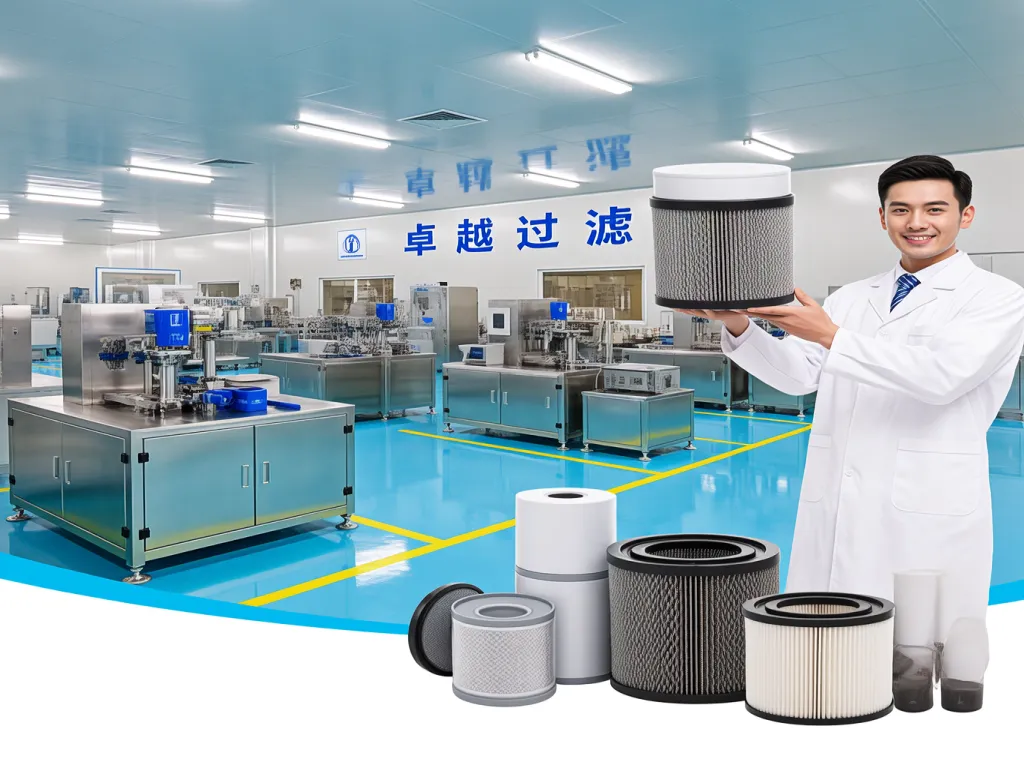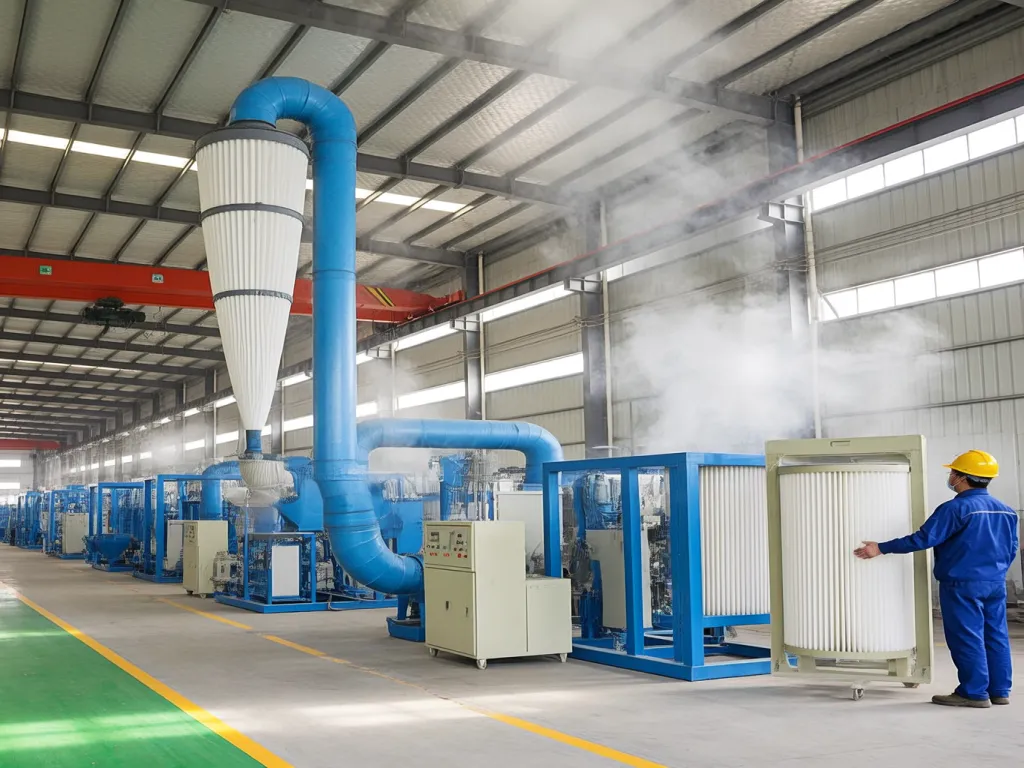Top Picks: Choosing Elite Industrial Filter Bag Suppliers

In the realm of industrial production, the quest for pristine air quality and equipment longevity hinges on one critical factor: filtration efficiency. When scouring the market for reliable solutions, the spotlight falls on industrial filter bag suppliers. But how do you sift through the noise and pinpoint suppliers that truly excel? This guide unveils the secrets to selecting industrial filter bag suppliers whose offerings not only meet but exceed your filtration expectations. Ever wondered what sets apart the best from the rest?

Understanding the Importance of Filtration Efficiency: How It Impacts Industrial Production
When it comes to industrial filtration, the term ‘filtration efficiency’ isn’t just a buzzword—it’s the cornerstone of operational excellence and environmental responsibility. As an industrial merchant or environmental engineer, you’re likely well aware of the challenges that come with managing dust emissions, protecting equipment, and ensuring compliance with stringent environmental regulations. But have you ever stopped to consider just how pivotal filtration efficiency is in all these aspects? Let’s dive deep into why filtration efficiency matters so much in industrial production.
Firstly, let’s talk about dust emissions. In industries like cement manufacturing, steel production, and power generation, dust is an inevitable byproduct. Left unchecked, these tiny particles can wreak havoc on the environment, leading to air pollution and potential health hazards for workers and nearby communities. This is where high-efficiency industrial filter bags come into play. By effectively capturing and retaining dust particles, these filter bags significantly reduce emissions, helping you meet or even exceed regulatory standards. For example, consider the high-efficiency industrial filter bag solution, which offers durability and exceptional filtration performance. Imagine the peace of mind knowing that your operations are not only efficient but also environmentally friendly.
But the benefits of filtration efficiency don’t stop there. Protecting your equipment is equally crucial. Dust and other particulates can cause abrasive wear on machinery, leading to premature failure and costly downtime. High-efficiency filter bags act as a barrier, preventing these harmful particles from reaching sensitive components. The result? Extended equipment lifespan, reduced maintenance costs, and improved overall operational reliability. It’s like giving your machinery a protective shield, ensuring it runs smoothly and efficiently for years to come.
Now, you might be wondering, ‘How do I know if a filter bag supplier truly offers high-efficiency products?’ That’s a great question, and one we’ll address in detail later. But for now, let’s focus on the tangible impacts of filtration efficiency. Consider a scenario where a manufacturing plant switches from low-efficiency to high-efficiency filter bags. The immediate effect is a noticeable drop in dust emissions, leading to cleaner air and a healthier work environment. Over time, the plant also observes a decrease in equipment breakdowns, translating to fewer interruptions and higher productivity. These are real-world examples of how filtration efficiency can transform industrial operations.
Reducing Dust Emissions: A Breath of Fresh Air
Dust emissions are a significant concern in many industrial sectors. They not only pollute the air but also pose health risks to workers and nearby residents. High-efficiency industrial filter bags are designed to capture even the smallest dust particles, ensuring that only clean air is released into the atmosphere. This reduction in emissions not only helps you comply with environmental regulations but also enhances your corporate image as a responsible and eco-friendly business. Plus, it’s a win-win for everyone—cleaner air means a healthier workforce and a happier community.
Protecting Equipment: The Longevity Factor
Equipment failure due to dust and particulate buildup is a common issue in industrial settings. High-efficiency filter bags play a crucial role in preventing this by acting as a first line of defense against harmful particles. By keeping your machinery clean and free from contaminants, these filter bags extend the lifespan of your equipment, reduce the need for frequent repairs, and minimize downtime. Think of it as an investment in the future of your operations—a small upfront cost that pays off in spades over time.
Enhancing Operational Efficiency: The Ripple Effect
The benefits of high-efficiency filtration extend beyond just dust reduction and equipment protection. They also have a ripple effect on your overall operational efficiency. Cleaner air means fewer health issues among workers, leading to lower absenteeism and higher productivity. Reduced equipment breakdowns mean fewer interruptions and more consistent output. And compliance with environmental regulations means avoiding fines and penalties that can eat into your profits. All these factors combine to create a more efficient, profitable, and sustainable industrial operation.

Evaluating Supplier Technical Strength: How to Assess Filter Bag Efficiency Through Technical Data and Case Studies
When you’re on the hunt for top-tier industrial filter bag suppliers, understanding their technical strength is crucial. After all, you want a supplier whose filter bags can truly deliver on efficiency, right? So, how do you go about assessing this? Let’s dive into two key avenues: technical data and case studies.
First up, technical data. This is like the DNA of a filter bag’s performance. When a supplier provides you with technical data sheets, they’re essentially giving you a peek under the hood. These sheets should detail everything from the material composition of the filter bag to its filtration efficiency ratings. Pay close attention to the filtration efficiency figures. This number tells you how much of the unwanted particles the bag can capture. For instance, if a supplier claims their bags have a 99.9% filtration efficiency, that’s a strong indicator of high performance. But don’t just take their word for it. Look for independent testing results or certifications that back up these claims. A reputable supplier will have no issue sharing this information.
Now, let’s talk about material composition. The type of material used in a filter bag can significantly impact its filtration efficiency. For example, bags made from high-quality synthetic fibers might offer better dust retention and longer lifespan compared to those made from cheaper, less durable materials. So, when reviewing technical data, ask yourself: Does the material align with my specific industrial needs? If you’re dealing with corrosive substances, you’ll want a bag that’s resistant to chemical degradation. If you’re in a high-temperature environment, thermal stability becomes a key factor. For a deeper understanding of how material composition affects performance, consider exploring specific product examples, such as this high-efficiency industrial filter bag.
Moving on to case studies. These are real-world examples of how a supplier’s filter bags have performed in similar industrial settings to yours. A good case study should provide a detailed account of the application, the challenges faced, and how the filter bags addressed those challenges. Look for case studies that mirror your industry or operational conditions. For instance, if you’re in the cement industry, a case study from a cement plant using the same type of filter bags would be highly relevant. These studies can give you a sense of the bag’s durability, maintenance requirements, and overall performance in a live environment.
But how do you interpret these case studies effectively? Start by looking at the metrics. Did the filter bags lead to a reduction in emissions? Were there any noticeable improvements in equipment longevity or operational efficiency? Also, pay attention to the feedback from the end-users. Are they satisfied with the performance? Would they recommend the supplier to others? These insights can be invaluable in making an informed decision.
Let’s not forget about the supplier’s research and development (R&D) capabilities. A supplier that invests heavily in R&D is likely to stay ahead of the curve in terms of technology and innovation. Ask about their R&D team, the projects they’re working on, and any patents they hold. This can give you a sense of their commitment to continuous improvement and their ability to adapt to changing industry standards.
In addition to technical data and case studies, don’t overlook the importance of customer support. Even the best filter bags can encounter issues. When that happens, you want a supplier that’s responsive and helpful. Look for suppliers that offer comprehensive after-sales support, including technical assistance, spare parts availability, and training for your staff.
So, as you sift through the technical data and case studies of potential industrial filter bag suppliers, remember to ask the right questions. What’s the filtration efficiency? What materials are used? How have these bags performed in similar settings? And what kind of support can I expect post-purchase? By thoroughly evaluating these aspects, you’ll be well on your way to finding a supplier that can meet your industrial filtration needs with top-notch efficiency.
Deciphering Technical Data Sheets
Technical data sheets are your go-to for understanding the nitty-gritty of a filter bag’s performance. Beyond filtration efficiency, look for details on airflow resistance, temperature tolerance, and chemical compatibility. These factors can greatly influence the bag’s suitability for your specific application. For instance, a bag with low airflow resistance might be ideal for systems where maintaining optimal airflow is critical. Similarly, a bag that can withstand high temperatures without degrading is essential for hot gas filtration processes.
Case Studies: The Proof is in the Performance
Case studies serve as living proof of a filter bag’s capabilities. They provide context, showing you not just what the bag can do, but how it does it in real-world scenarios. When reviewing case studies, pay attention to the duration of the study. Longer studies often offer a more accurate picture of the bag’s durability and long-term performance. Also, consider the scale of the application. A case study from a large-scale industrial operation can give you confidence that the bag can handle high-volume filtration tasks.
The Role of R&D in Supplier Selection
A supplier’s R&D efforts can be a game-changer. Companies that prioritize innovation are more likely to offer cutting-edge filter bag solutions that address emerging industry challenges. Inquire about their R&D process, the frequency of new product launches, and how they gather feedback from the field. A supplier that actively engages with its customers to refine its products is one that’s committed to excellence.

On-Site Inspection and Testing: The Importance of Visiting Supplier Production Lines, Conducting Filter Bag Performance Tests, and Interpreting Test Reports
When it comes to selecting the right industrial filter bag suppliers, there’s no substitute for firsthand experience. Sure, you can pore over brochures, websites, and technical specifications all day long. But have you ever considered the power of a physical visit to the supplier’s production line? Or the insights gained from conducting your own filter bag performance tests? Let’s dive into why these steps are not just beneficial but essential in your quest for top-tier industrial filter bag suppliers.
First off, visiting a supplier’s production line gives you a front-row seat to their manufacturing prowess. You get to see the machinery in action, the quality control measures in place, and the overall environment where your filter bags are born. It’s like peeking behind the curtain of a magic show – suddenly, everything becomes clearer. You can observe the materials being used, the attention to detail in the construction process, and even the workers’ demeanor. All these elements contribute to the final product’s quality, and nothing beats seeing it with your own eyes.
But why stop at observation? Conducting your own filter bag performance tests is where the rubber really meets the road. These tests are designed to simulate real-world conditions, giving you a clear picture of how the filter bags will perform in your specific industrial setting. Will they withstand the high temperatures? Can they handle the corrosive chemicals? Do they efficiently capture the particles you need to remove? By conducting these tests, you’re not just relying on the supplier’s word; you’re getting concrete evidence of the filter bags’ capabilities.
Now, let’s talk about interpreting those test reports. At first glance, a test report might seem like a jumble of numbers and technical jargon. But fear not! With a little guidance, you can turn that report into a goldmine of information. Start by looking at the key performance indicators (KPIs) relevant to your industry. For instance, if you’re in the cement industry, you’ll want to pay close attention to the filter bags’ ability to capture fine dust particles. Compare these KPIs against industry standards or even your current filter bags’ performance. Are the new filter bags an improvement? If so, by how much?
But don’t just stop at the numbers. Look for any anomalies or inconsistencies in the test results. Did the filter bags perform differently under certain conditions? If so, why? Understanding these nuances can help you make more informed decisions about which filter bags are best suited for your needs. It’s also worth noting any additional information provided in the report, such as the test methodology or the conditions under which the tests were conducted. This context can be invaluable in interpreting the results accurately.
So, you might be wondering, ‘How do I go about conducting these tests?’ Well, that’s where collaboration with the supplier comes in. Many reputable industrial filter bag suppliers offer testing services as part of their package. They have the expertise, the equipment, and the facilities to conduct rigorous tests that simulate your specific industrial conditions. By working closely with them, you can ensure that the tests are tailored to your needs and that the results are interpreted correctly.
In conclusion, visiting a supplier’s production line and conducting your own filter bag performance tests are not just optional steps in the supplier selection process; they’re essential. They provide you with firsthand insights into the supplier’s manufacturing capabilities and the filter bags’ real-world performance. And by learning how to interpret test reports effectively, you can make more informed decisions that lead to better filtration outcomes for your industrial operations. So, the next time you’re in the market for industrial filter bags, remember: see it, test it, interpret it, and then decide. Your industrial processes – and your bottom line – will thank you for it.
Navigating the landscape of industrial filter bag suppliers requires a discerning eye and a strategic approach. By prioritizing filtration efficiency, assessing technical prowess, and conducting thorough on-site evaluations, you’re poised to partner with suppliers that elevate your industrial operations. Remember, the right industrial filter bag suppliers are not just vendors; they’re collaborators in your journey towards enhanced productivity and environmental stewardship. Ready to transform your filtration setup? Dive deeper into our recommendations and take the first step towards a cleaner, more efficient future.

